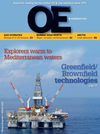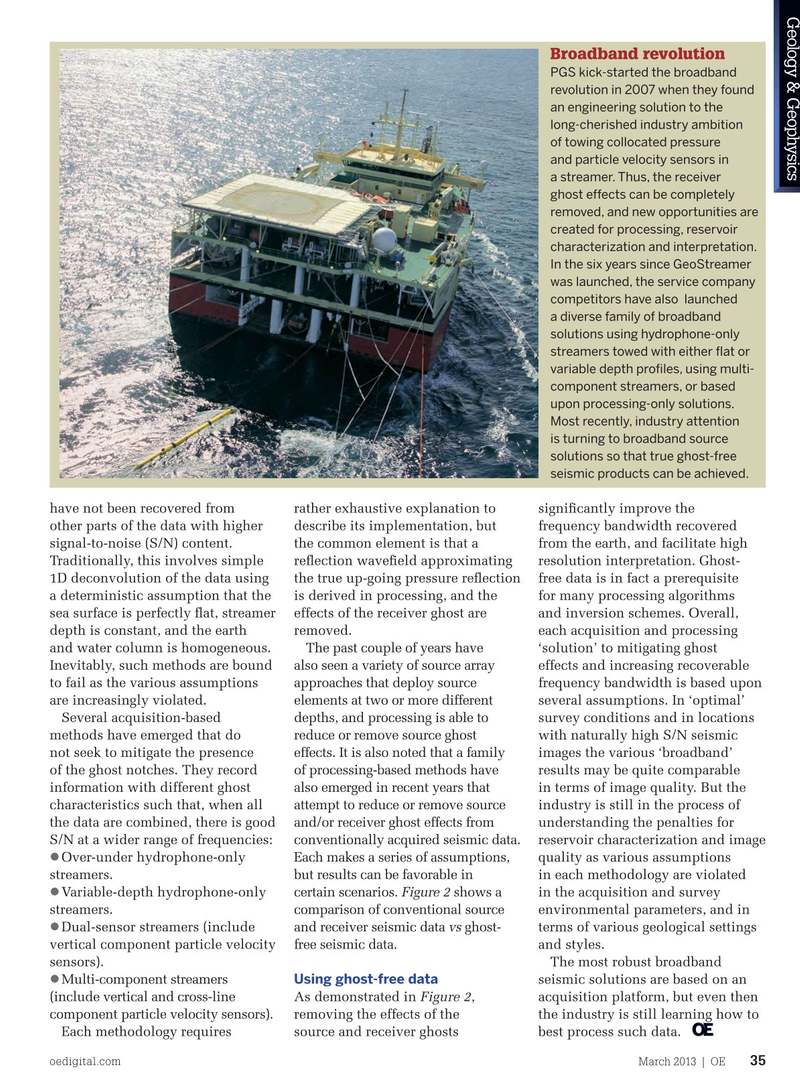
Page 33: of Offshore Engineer Magazine (Mar/Apr 2013)
Read this page in Pdf, Flash or Html5 edition of Mar/Apr 2013 Offshore Engineer Magazine
Geology & Geophysics
Broadband revolution
PGS kick-started the broadband revolution in 2007 when they found an engineering solution to the long-cherished industry ambition of towing collocated pressure and particle velocity sensors in a streamer. Thus, the receiver ghost effects can be completely removed, and new opportunities are created for processing, reservoir characterization and interpretation.
In the six years since GeoStreamer was launched, the service company competitors have also launched a diverse family of broadband solutions using hydrophone-only streamers towed with either fat or variable depth profles, using multi- component streamers, or based upon processing-only solutions.
Most recently, industry attention is turning to broadband source solutions so that true ghost-free seismic products can be achieved.
have not been recovered from rather exhaustive explanation to signifcantly improve the other parts of the data with higher describe its implementation, but frequency bandwidth recovered signal-to-noise (S/N) content. the common element is that a from the earth, and facilitate high
Traditionally, this involves simple refection wavefeld approximating resolution interpretation. Ghost- 1D deconvolution of the data using the true up-going pressure refection free data is in fact a prerequisite a deterministic assumption that the is derived in processing, and the for many processing algorithms sea surface is perfectly fat, streamer effects of the receiver ghost are and inversion schemes. Overall, depth is constant, and the earth removed. each acquisition and processing and water column is homogeneous. The past couple of years have ‘solution’ to mitigating ghost
Inevitably, such methods are bound also seen a variety of source array effects and increasing recoverable to fail as the various assumptions approaches that deploy source frequency bandwidth is based upon are increasingly violated. elements at two or more different several assumptions. In ‘optimal’ Several acquisition-based depths, and processing is able to survey conditions and in locations methods have emerged that do reduce or remove source ghost with naturally high S/N seismic not seek to mitigate the presence effects. It is also noted that a family images the various ‘broadband’ of the ghost notches. They record of processing-based methods have results may be quite comparable information with different ghost also emerged in recent years that in terms of image quality. But the characteristics such that, when all attempt to reduce or remove source industry is still in the process of the data are combined, there is good and/or receiver ghost effects from understanding the penalties for
S/N at a wider range of frequencies: conventionally acquired seismic data. reservoir characterization and image l Over-under hydrophone-only Each makes a series of assumptions, quality as various assumptions streamers. but results can be favorable in in each methodology are violated l Variable-depth hydrophone-only certain scenarios. Figure 2 shows a in the acquisition and survey streamers. comparison of conventional source environmental parameters, and in l Dual-sensor streamers (include and receiver seismic data vs ghost- terms of various geological settings vertical component particle velocity free seismic data. and styles. sensors). The most robust broadband l Multi-component streamers Using ghost-free data seismic solutions are based on an (include vertical and cross-line As demonstrated in Figure 2, acquisition platform, but even then component particle velocity sensors). removing the effects of the the industry is still learning how to Each methodology requires source and receiver ghosts best process such data.
oedigital.com March 2013 | OE 35 oe_PGS_rev2.indd 35 27/02/2013 11:37

 32
32

 34
34